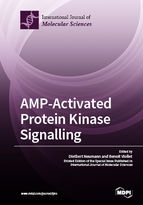AMP-Activated Protein Kinase Signalling
A special issue of International Journal of Molecular Sciences (ISSN 1422-0067). This special issue belongs to the section "Biochemistry".
Deadline for manuscript submissions: closed (30 September 2018) | Viewed by 199920
Special Issue Editors
Interests: AMP-activated protein kinase; phosphorylation; protein biochemistry; expression and characterization of protein complexes; molecular mechanisms; cellular signalling; metabolic disease; therapeutic avenues
Special Issues, Collections and Topics in MDPI journals
Interests: AMP-activated protein kinase; molecular mechanisms; cellular signalling; metabolic disease; therapeutic avenues; animal models
Special Issues, Collections and Topics in MDPI journals
Special Issue Information
Dear Colleagues,
This Special Issue on “AMP-Activated Protein Kinase (AMPK) Signalling” will cover recent advances in this expanding field, ranging from molecular and cellular to in vivo approaches, including human disease relevance and drug research. Up-to-date reviews, research articles and short communications will all be considered.
Starting from a kinase of interest, AMPK has gone far beyond an average biomolecule. Being expressed in all mammalian cell types and probably having a counterpart in every eukaryotic cell, AMPK has attracted interest in virtually all areas of biological research. Structural and biophysical insights have greatly contributed to a molecular understanding of this kinase. From the good old protein biochemistry to modern approaches, such as systems biology and advanced microscopy, all disciplines provided with important information. Thus, multiple links to cellular events and subcellular localizations have been established. Moreover, the involvement of AMPK in human health and disease has been evidenced. AMPK accordingly has moved from an interesting enzyme to a pharmacological target. However, despite our extensive current knowledge about AMPK, the growing community is more busy than ever. Authors are invited to submit manuscripts in all areas of recent and current AMPK research with an emphasis on work providing with molecular insight, including but not limited to novel physiological and pathological functions, or regulatory mechanisms.
We welcome your contributions for this Special Issue on AMP-activated protein kinase signalling.
Dr. Dietbert Neumann
Dr. Benoit Viollet
Guest Editors
Manuscript Submission Information
Manuscripts should be submitted online at www.mdpi.com by registering and logging in to this website. Once you are registered, click here to go to the submission form. Manuscripts can be submitted until the deadline. All submissions that pass pre-check are peer-reviewed. Accepted papers will be published continuously in the journal (as soon as accepted) and will be listed together on the special issue website. Research articles, review articles as well as short communications are invited. For planned papers, a title and short abstract (about 100 words) can be sent to the Editorial Office for announcement on this website.
Submitted manuscripts should not have been published previously, nor be under consideration for publication elsewhere (except conference proceedings papers). All manuscripts are thoroughly refereed through a single-blind peer-review process. A guide for authors and other relevant information for submission of manuscripts is available on the Instructions for Authors page. International Journal of Molecular Sciences is an international peer-reviewed open access semimonthly journal published by MDPI.
Please visit the Instructions for Authors page before submitting a manuscript. There is an Article Processing Charge (APC) for publication in this open access journal. For details about the APC please see here. Submitted papers should be well formatted and use good English. Authors may use MDPI's English editing service prior to publication or during author revisions.
Keywords
- AMP-activated protein kinase
- phosphorylation
- regulatory mechanisms
- cellular signalling
- human disease
- therapeutic approaches








